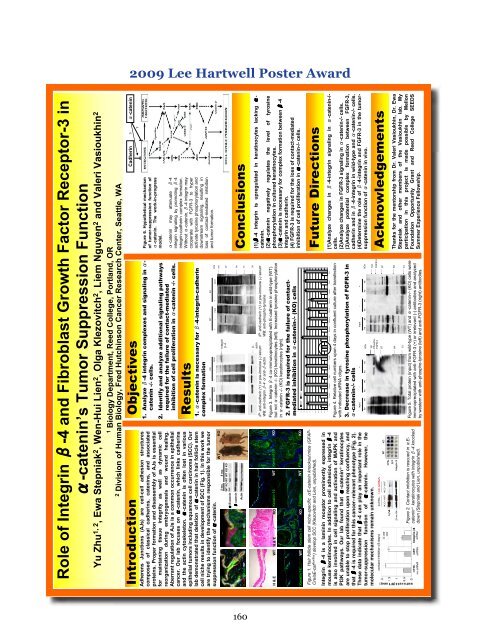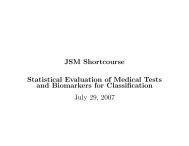Summer Undergraduate Research Program - Fred Hutchinson ...
Summer Undergraduate Research Program - Fred Hutchinson ...
Summer Undergraduate Research Program - Fred Hutchinson ...
You also want an ePaper? Increase the reach of your titles
YUMPU automatically turns print PDFs into web optimized ePapers that Google loves.
Role of Integrin β-4 and Fibroblast Growth Factor Receptor-3 in<br />
α-catenin’s Tumor Suppression Function<br />
Yu Zhu1, 2 , Ewa Stepniak2 , Wen-Hui Lien2 , Olga Klezovitch2 , Liem Nguyen2 and Valeri Vasioukhin2 1 Biology Department, Reed College, Portland, OR<br />
2 Division of Human Biology, <strong>Fred</strong> <strong>Hutchinson</strong> Cancer <strong>Research</strong> Center, Seattle, WA<br />
2009 Lee Hartwell Poster Award<br />
Cadherin ? α-catenin<br />
?<br />
Objectives<br />
Introduction<br />
Figure 6. Hypothetical mechanism<br />
of tumor-suppression function of<br />
α-catenin. The work-in-progress<br />
model.<br />
1. Analyze β-4 integrin complexes and signaling in αcatenin<br />
-/- cells.<br />
2. Identify and analyze additional signaling pathways<br />
required for the failure of contact-mediated<br />
α-catenin may attenuate β-4<br />
integrin signaling by promoting β-4<br />
integrin-cadherin complex formation.<br />
Without α-catenin, β-4 integrin may<br />
cooperate with FGFR-3 to hyper<br />
activate tyrosine phosphorylation and<br />
downstream signaling, resulting in<br />
loss of contact-mediated inhibition<br />
and tumor formation.<br />
inhibition of cell proliferation in α-catenin -/- cells.<br />
Results<br />
1. α-catenin is necessary for β-4-integrin-cadherin<br />
complex formation<br />
Adherens Junctions (AJs) are cell-cell adhesion structures<br />
composed of classical cadherins, catenins, and associated<br />
proteins. Proper formation and disassembly of AJs is essential<br />
for maintaining tissue integrity as well as dynamic cell<br />
reorganization during embryogenesis and wound healing.<br />
Aberrant regulation of AJs is a common occurrence in epithelial<br />
cancer. Our lab focuses on α-catenin, which links cadherins<br />
and the actin cytoskeleton. α-catenin is often lost in various<br />
epithelial tumors including squamous cell carcinoma (SCC). Our<br />
lab demonstrated that deletion of α-catenin in hair follicle stem<br />
cell niche results in development of SCC (Fig. 1). In this work we<br />
are trying to identify the mechanisms responsible for the tumor<br />
suppression function of α-catenin.<br />
WT KO<br />
kDa<br />
WT KO WT KO<br />
+ - Input + - Input<br />
+ - Input + - Input<br />
191<br />
Integrin<br />
β-4<br />
97<br />
WT KO WT WT KO KO<br />
2 mo. 4 mo.<br />
Conclusions<br />
64<br />
α-Ecatenin<br />
β-catenin<br />
Actin<br />
51<br />
E-cad αE-cat KO<br />
E-cad αE-cat WT<br />
160<br />
(1)β-4 integrin is upregulated in keratinocytes lacking αcatenin.<br />
(2)α-catenin negatively regulates the level of tyrosine<br />
phosphorylation in cultured keratinocytes.<br />
(3)α-catenin is necessary for complex formation between β-4<br />
integrin and cadherin.<br />
(4) FGFR-3 is required for the loss of contact-mediated<br />
inhibition of cell proliferation in α-catenin-/- cells.<br />
β-<br />
39<br />
actin<br />
IP: anti-cadherin (+) or pre-immune (-) serum IP: anti-cadherin (+) or pre-immune (-) serum<br />
WB: anti-integrin β-4 or anti-β-actin<br />
WB: anti-phospho-tyrosine<br />
Figure 3. Integrin β-4 co-immunoprecipitated with E-cadherin in wild-type (WT)<br />
but not α-catenin -/- (KO) keratinocytes (left). Increased tyrosine phosphorylation<br />
in α-catenin -/- (KO) keratinocytes (right).<br />
2. FGFR-3 is required for the failure of contactmediated<br />
inhibition in α-catenin-/- (KO) cells<br />
Keratin 10 WT Keratin 10 KO<br />
H & E WT H & E KO<br />
WT KO<br />
2<br />
1.8<br />
Filagrin WT Filagrin KO<br />
Keratin 14 WT Keratin 14 KO<br />
1.6<br />
1.4<br />
Cre/aE-catflox/flox 1.2<br />
1<br />
) develop SCC (Klezovitch and Lien, unpublished). 0.8<br />
Future Directions<br />
Figure 1. Hair follicle stem cell niche-specific αE-catenin knockout mice (GFAP-<br />
0.6<br />
0.4<br />
(1)Analyze changes in β-4-integrin signaling in α-catenin-/cells.<br />
(2)Analyze changes in FGFR-3 signaling in α-catenin-/- cells.<br />
(3)Analyze potential complex formation between FGFR-3,<br />
cadherin and in β-4-integrin in wild-type and α-catenin-/- cells.<br />
(4)Determine the role of β-4-integrin and FGFR-3 in the tumorsuppression<br />
function of α-catenin in vivo.<br />
0.2<br />
0<br />
Ctrl Erbb3 Erbb2 Met Mst1r Fgrf2 Fgrf3 Epha2 Epha1 Ephb4 Shc1 Ptpn11 Itga6 Ptk6 Frk<br />
Figure 4. Relative cell numbers upon 4 days in confluent culture after transfection<br />
with indicated siRNA oligos.<br />
3. Decrease in tyrosine phosphorylation of FGFR-3 in<br />
α-catenin-/- cells<br />
kDa<br />
input - +<br />
input - +<br />
ko wt ko wt ko wt kDa<br />
ko wt ko wt ko wt<br />
Integrin β-4 is a laminin receptor prominently expressed in<br />
mouse keratinocytes. In addition to cell adhesion, integrin β-4<br />
is also involved in cell signaling and activation of MAPK and<br />
PI3K pathways. Our lab found that α-catenin-/- keratinocytes<br />
are unable to stop proliferation upon reaching confluency, and<br />
that β-4 is required for this cancer–relevant phenotype (Fig. 2).<br />
These data indicate that β-4 can play an important role in the<br />
tumor-suppression function of α-catenin. However, the<br />
molecular mechanisms remain unknown.<br />
Acknowledgements<br />
191<br />
FGFR-3<br />
191<br />
Phospho-<br />
FGFR-3<br />
97<br />
97<br />
Thanks for the mentorship from Dr. Valeri Vasioukhin, Dr. Ewa<br />
Stepniak and other members of the Vasioukhin lab. My<br />
participation in this project is made possible by Mellon<br />
Foundation Opportunity Grant and Reed College SEEDS<br />
<strong>Summer</strong> Experience Fellowship.<br />
64<br />
64<br />
51<br />
51<br />
Figure 5. Total protein (input) from wild-type (WT) and α-catenin-/- (KO) cells were<br />
immunoprecipitated with anti-FGFR-3 (+) or irrelevant (-) antibodies and analyzed<br />
by western with anti-phospho-tyrosine (left) and anti-FGFR-3 (right) antibodies.<br />
Figure 2. Contact inhibition is rescued in αEcatenin-/-<br />
keratinocytes with integrin β-4 knocked<br />
down (Stepniak and Lien, unpublished).
















